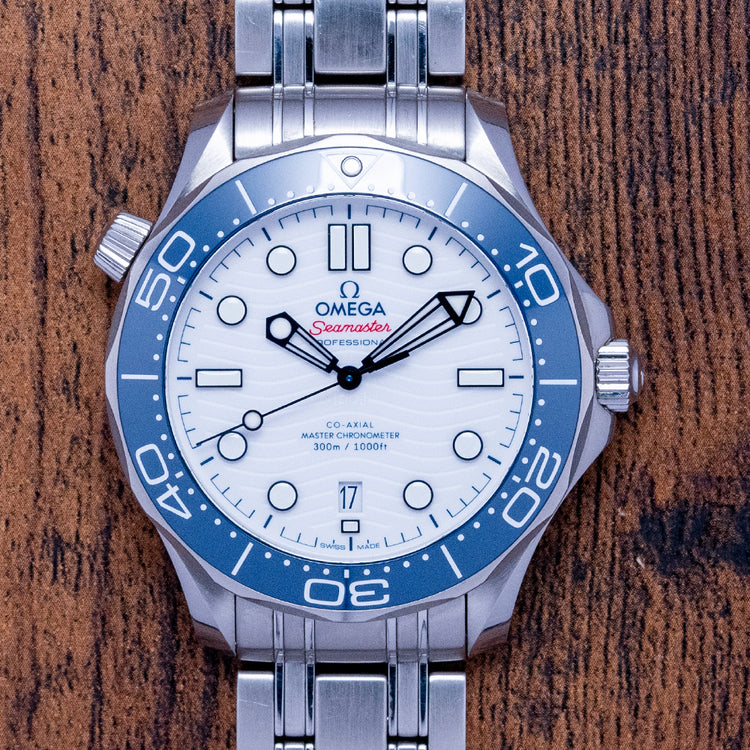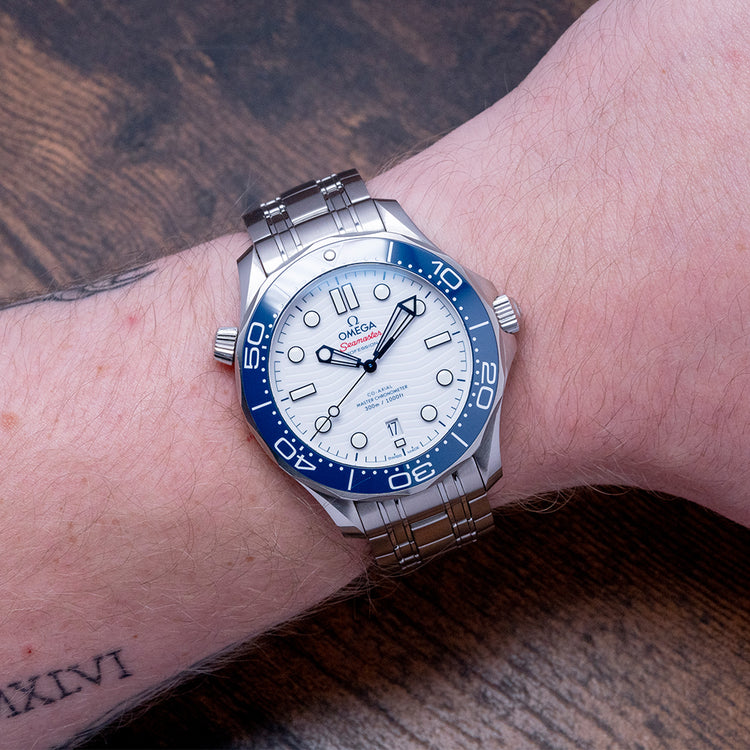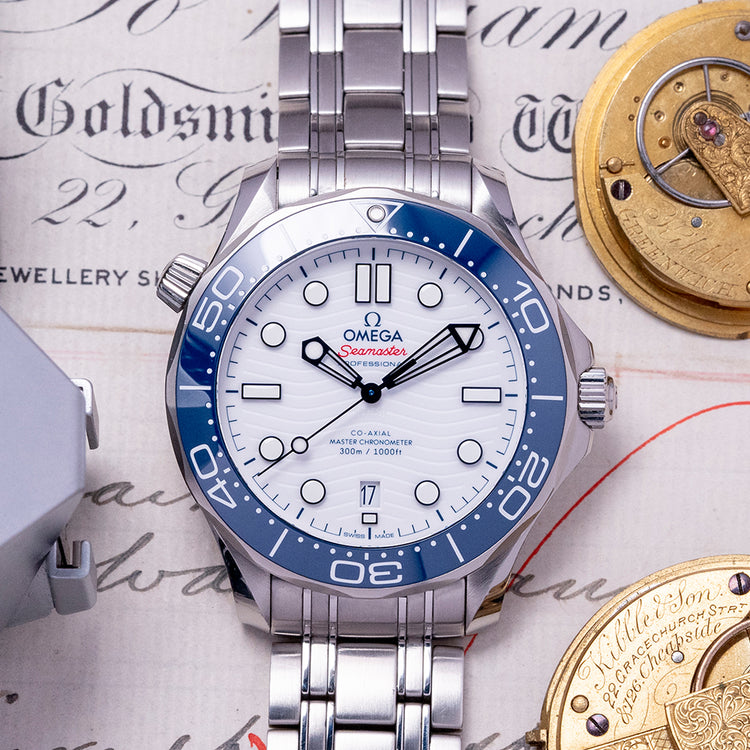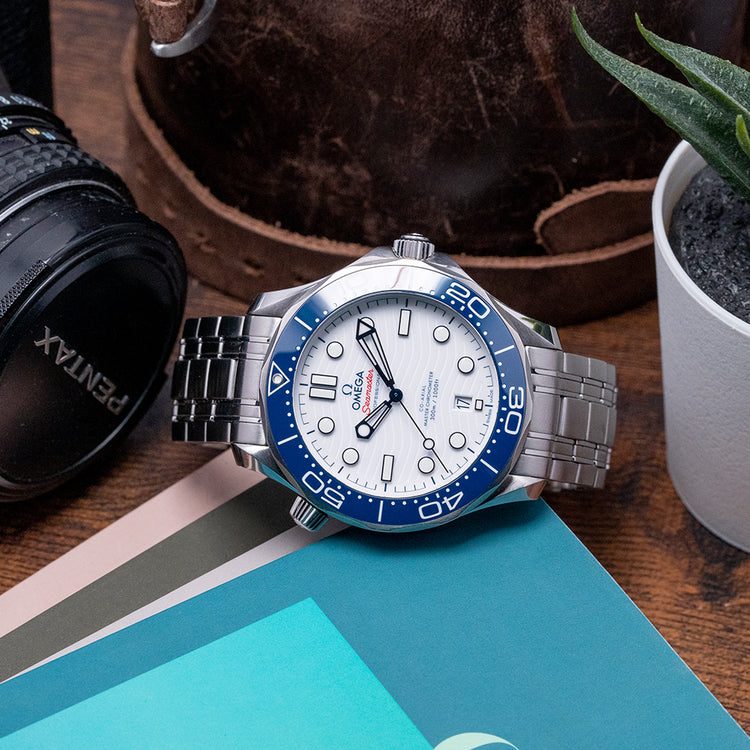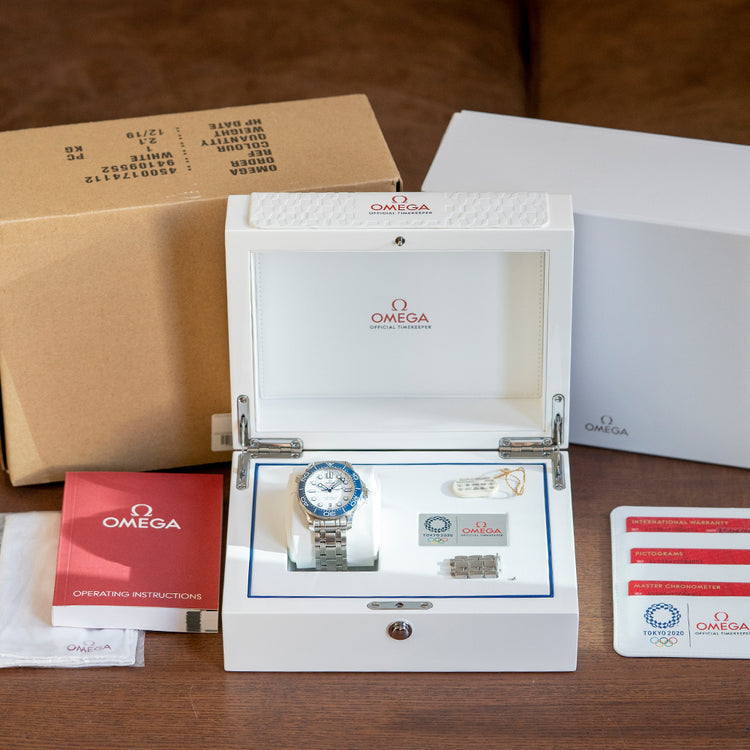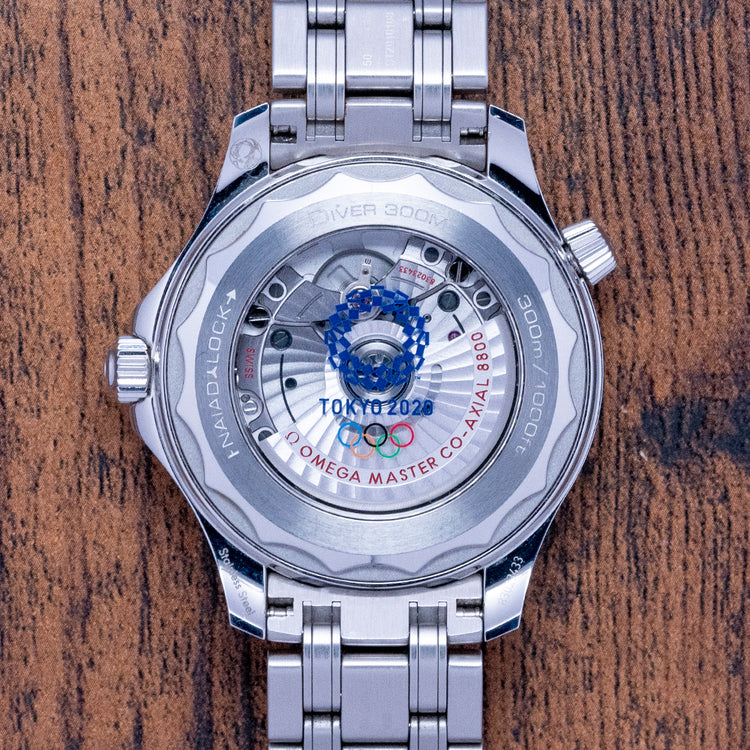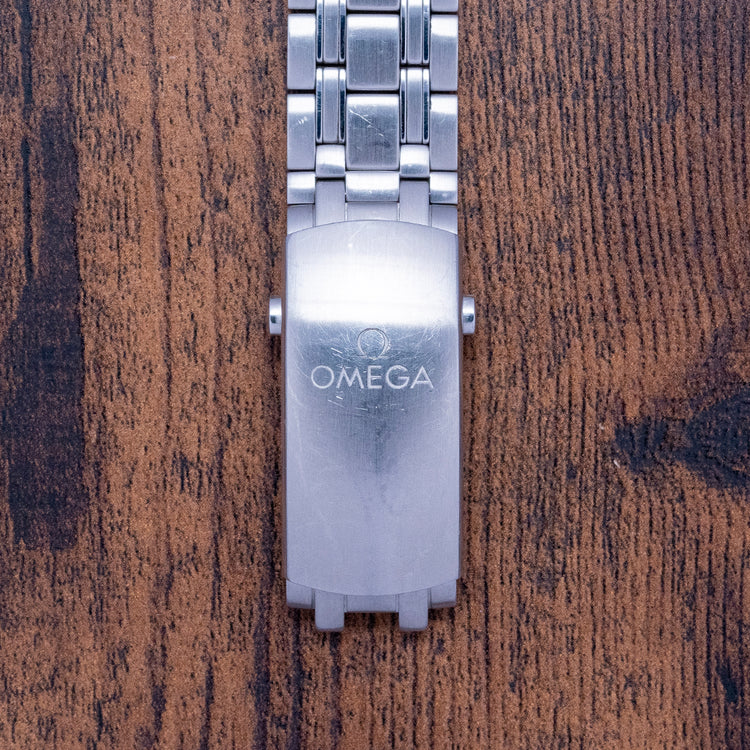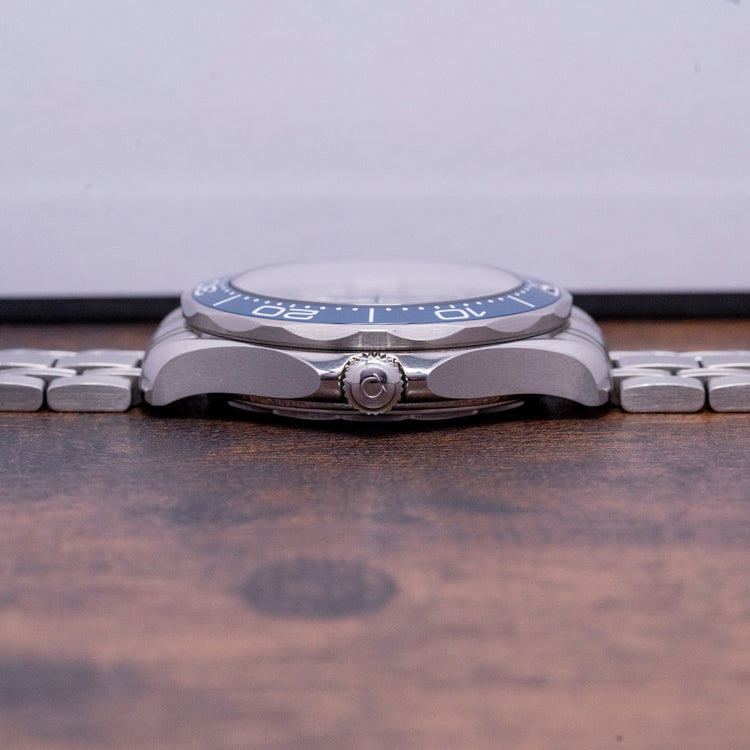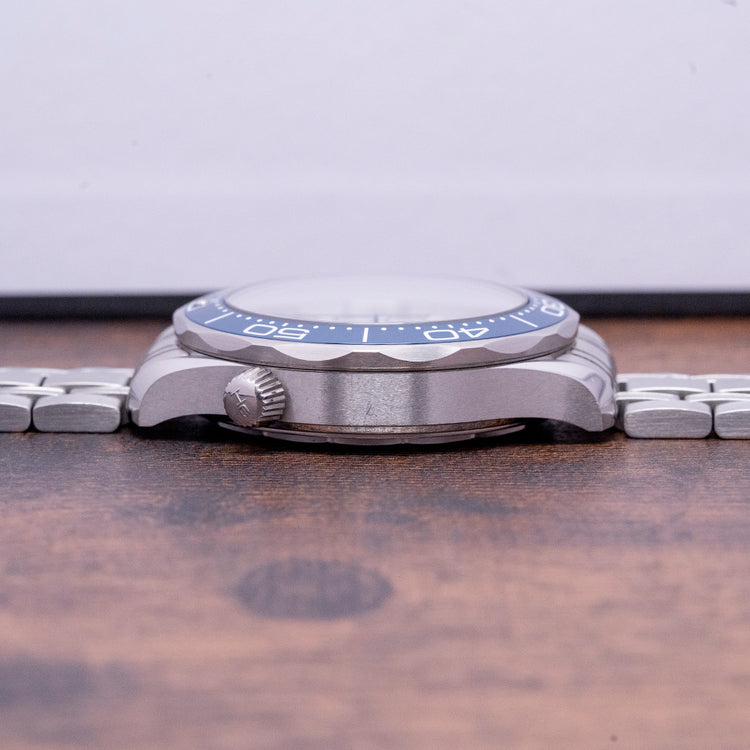More Information
Description
More
Less
The Watch
Here we have a 2021 Omega Seamaster Tokyo 2020 Limited Edition 522.30.42.20.04.001 introduced to celebrate being the Official Timekeeper of the Olympic Games Tokyo 2020. The 42mm stainless steel case curves over your wrist with the twisted lugs associated with a modern Seamaster, and a lug-to-lug length of 50mm and a case thickness of 13.5mm give the watch an impressive wrist presence. On the right side, we have a protected screw-down crown, on the left side at 10 o’clock we have the Helium escape valve. The scalloped-edged unidirectional bezel has a ceramic blue insert with a white enamel dive scale. A domed sapphire crystal AR coated on both sides sits above a polished white ceramic dial with a laser-cut wave pattern, creating depth to the dial. An outer minute track in blue with applied disc and baton indexes coated in SuperLumiNova marks the hours. At 6 o’clock a date window. Skeletonised sword hands with luminance tips are complemented by a sweeping lollipop centre second hand. The text is precisely printed in blue with a red “Seamaster”. On the reverse, a screw-down exhibition case back with the NAIAD Lock system, the system is patented, the patent roughly states it's a locking system designed for a screw-down case back that allows the user to orient engravings in proper alignment without matching a given case back to a given case. “Naiad” is Greek for mythical water spirits. Inside an automatic Omega Co-Axial 8800, 35 jewels, 25,200 beats per hour, a Certified Master Chronometer, approved by METAS,” Swiss National Metrology Institute”. The watch goes through COSC certification before being selected for the eight tests run by METAS. This movement is resistant to magnetic fields. It has a silicon balance spring that winds in both directions. Finished in Rhodium plating and decorated with Geneva waves. The watch comes fitted on its 20mm Omega brushed and polished stainless steel bracelet with its signed folding push-button release clasp, all links are provided, and the watch comes with its Omega presentation box, swing tag and papers.
Points of Mention
This watch is sold with its original Omega presentation box, swing tag and paperwork. The watch is paired with its original 20mm Omega stainless steel bracelet with its signed push-button release folding clasp. The watch is from June 2021 and is sold in used condition, as you can see, a full case and bracelet refurb can be provided at an additional cost on request. The watch comes with our 12-Months Warranty.
For more photos see here - https://drive.google.com/drive/folders/1U2A8tKBq9KM1LufHjKVxZ9x0oy8Rz2R7?usp=drive_link
4K YouTube video, skip to 14:11 - https://youtu.be/hm13BLBtHIw
Personal Note
There is no denying how attractive this Omega Seamaster "Tokyo 2020" Olympics model is the vibrant blue bezel contrasting boldly against the bright white dial! I'm also a big fan of watches that commemorate an event without splashing said events logo or branding all over the dial, this has the logo on the caseback and its nicely done! This means if you just like the design, you can buy and enjoy it without feeling like a walking advertisement, which I feel has been part of the reason for the great success of this model.
Specification
Lugs : 20mm
Condition : Pre-Owned
Box & Papers : Box & Papers
Case Material : Stainless Steel
Warranty : 12-Months Warranty
The Brand
They were formerly known as the La Generale Watch Co. in 1848 founded by Louis Brandt in La Chaux-de-Fonds. When he died in 1879, his sons carried on his dream. In 1880 they moved to 96 Rue Jakob-Stampfli where they remain today. The brothers produced their first mass-produced calibre, the Labrador In 1885. Just a few years later in 1892, they produced the first minute-repeater. In 1903 they renamed the company Omega until 1982 when they officially changed their name to Omega SA. During WW1 Omega watches were used as official timekeepers for the Royal Flying Corps and the US Army. In 1930, Omega and Tissot merged together to form Société Suisse pour l'Industrie Horlogère (SSIH) In 1931, another group was formed - Allgemeine Schweizerische Uhrenindustrie AG (ASUAG). Where SSIH was primarily French-speaking, ASUAG was founded by the more German-speaking members of the Swiss watch industry. In 1948 they introduced the first edition of one of its most symbolic watches: the Seamaster. Omega first introduced the Constellation in 1952. At the time it was Omega's flagship timepiece. The first models had a Cal. 354 bumper movement in them. Later in 1955, Omega introduced the Automatic Cal. 50x, followed in 1959 by the Cal.55x (no date) and 56x (date) versions. Many of the Constellations came with pie-pan dials, diamond indexes, and fancy lug configurations. All the gold Constellations of that time have the Observatory of Geneva's hand engraved on the back. The stainless steel and stainless steel/gold versions had a gold medallion on the back with the Observatory of Geneva. The eight stars above the Observatory stand for the many exploits of Omega in the world Chronometer competition. They were celebrating the fact that all Constellations are Chronometer Certified. In 1962, when astronaut Wally Schirra wore a Speedmaster on his Mercury Sigma 7 Mission, making it the first Omega watch to enter space. After rigorous tests, NASA used Omega for all their Apollo missions including the 1969 Moon landing of Apollo 11. Today Omega is still an astronaut's first choice. In 1969, President Nixon famously said it was “too valuable” and turned down the first-ever all-gold Speedmaster Professional Deluxe. As a response to the ever-growing threat of electronic watches to the manufacturers of mechanical watches, Omega and many Swiss brands such as Rolex and Patek Philippe formed Centre Electronique Horologer (CEH). Prototypes began to appear in 1967 with their production starting in 1968. Then In 1972, Omega introduced the reference, 198.030, which included the Omega calibre 1250, a ‘tuning-fork electronic movement which was made under licence from Bulova. Later we saw a merger of SSIH and ASUAG into SMH, or Société de Microélectronique et d’Horlogerie. This merger took place in 1983. In 1992, the company acquired Blancpain, and in 1998 it officially rebranded itself from SMH to the Swatch Group. Then, in 1999, they purchased and integrated Breguet into the Swatch Group.
Points of Mention
More
Less
Personal Note
More
Less
Specification
More
Less
Movement : Automatic Omega Cal. 8800
Age : June 2021
Year : 2021
Case Size : 42mm
Case Thickness : 13.5 mm
Lug to Lug : 50mm
Lugs : 20mm
Condition : Pre-Owned
Case Material : Stainless Steel
Warranty : 12-Months Warranty
The wrist model's wrist size is 7inch
About Omega
More
Less
Description
The Watch
Here we have a 2021 Omega Seamaster Tokyo 2020 Limited Edition 522.30.42.20.04.001 introduced to celebrate being the Official Timekeeper of the Olympic Games Tokyo 2020. The 42mm stainless steel case curves over your wrist with the twisted lugs associated with a modern Seamaster, and a lug-to-lug length of 50mm and a case thickness of 13.5mm give the watch an impressive wrist presence. On the right side, we have a protected screw-down crown, on the left side at 10 o’clock we have the Helium escape valve. The scalloped-edged unidirectional bezel has a ceramic blue insert with a white enamel dive scale. A domed sapphire crystal AR coated on both sides sits above a polished white ceramic dial with a laser-cut wave pattern, creating depth to the dial. An outer minute track in blue with applied disc and baton indexes coated in SuperLumiNova marks the hours. At 6 o’clock a date window. Skeletonised sword hands with luminance tips are complemented by a sweeping lollipop centre second hand. The text is precisely printed in blue with a red “Seamaster”. On the reverse, a screw-down exhibition case back with the NAIAD Lock system, the system is patented, the patent roughly states it's a locking system designed for a screw-down case back that allows the user to orient engravings in proper alignment without matching a given case back to a given case. “Naiad” is Greek for mythical water spirits. Inside an automatic Omega Co-Axial 8800, 35 jewels, 25,200 beats per hour, a Certified Master Chronometer, approved by METAS,” Swiss National Metrology Institute”. The watch goes through COSC certification before being selected for the eight tests run by METAS. This movement is resistant to magnetic fields. It has a silicon balance spring that winds in both directions. Finished in Rhodium plating and decorated with Geneva waves. The watch comes fitted on its 20mm Omega brushed and polished stainless steel bracelet with its signed folding push-button release clasp, all links are provided, and the watch comes with its Omega presentation box, swing tag and papers.
Points of Mention
This watch is sold with its original Omega presentation box, swing tag and paperwork. The watch is paired with its original 20mm Omega stainless steel bracelet with its signed push-button release folding clasp. The watch is from June 2021 and is sold in used condition, as you can see, a full case and bracelet refurb can be provided at an additional cost on request. The watch comes with our 12-Months Warranty.
For more photos see here - https://drive.google.com/drive/folders/1U2A8tKBq9KM1LufHjKVxZ9x0oy8Rz2R7?usp=drive_link
4K YouTube video, skip to 14:11 - https://youtu.be/hm13BLBtHIw
Personal Note
There is no denying how attractive this Omega Seamaster "Tokyo 2020" Olympics model is the vibrant blue bezel contrasting boldly against the bright white dial! I'm also a big fan of watches that commemorate an event without splashing said events logo or branding all over the dial, this has the logo on the caseback and its nicely done! This means if you just like the design, you can buy and enjoy it without feeling like a walking advertisement, which I feel has been part of the reason for the great success of this model.
Specification
Lugs : 20mm
Condition : Pre-Owned
Box & Papers : Box & Papers
Case Material : Stainless Steel
Warranty : 12-Months Warranty
The Brand
They were formerly known as the La Generale Watch Co. in 1848 founded by Louis Brandt in La Chaux-de-Fonds. When he died in 1879, his sons carried on his dream. In 1880 they moved to 96 Rue Jakob-Stampfli where they remain today. The brothers produced their first mass-produced calibre, the Labrador In 1885. Just a few years later in 1892, they produced the first minute-repeater. In 1903 they renamed the company Omega until 1982 when they officially changed their name to Omega SA. During WW1 Omega watches were used as official timekeepers for the Royal Flying Corps and the US Army. In 1930, Omega and Tissot merged together to form Société Suisse pour l'Industrie Horlogère (SSIH) In 1931, another group was formed - Allgemeine Schweizerische Uhrenindustrie AG (ASUAG). Where SSIH was primarily French-speaking, ASUAG was founded by the more German-speaking members of the Swiss watch industry. In 1948 they introduced the first edition of one of its most symbolic watches: the Seamaster. Omega first introduced the Constellation in 1952. At the time it was Omega's flagship timepiece. The first models had a Cal. 354 bumper movement in them. Later in 1955, Omega introduced the Automatic Cal. 50x, followed in 1959 by the Cal.55x (no date) and 56x (date) versions. Many of the Constellations came with pie-pan dials, diamond indexes, and fancy lug configurations. All the gold Constellations of that time have the Observatory of Geneva's hand engraved on the back. The stainless steel and stainless steel/gold versions had a gold medallion on the back with the Observatory of Geneva. The eight stars above the Observatory stand for the many exploits of Omega in the world Chronometer competition. They were celebrating the fact that all Constellations are Chronometer Certified. In 1962, when astronaut Wally Schirra wore a Speedmaster on his Mercury Sigma 7 Mission, making it the first Omega watch to enter space. After rigorous tests, NASA used Omega for all their Apollo missions including the 1969 Moon landing of Apollo 11. Today Omega is still an astronaut's first choice. In 1969, President Nixon famously said it was “too valuable” and turned down the first-ever all-gold Speedmaster Professional Deluxe. As a response to the ever-growing threat of electronic watches to the manufacturers of mechanical watches, Omega and many Swiss brands such as Rolex and Patek Philippe formed Centre Electronique Horologer (CEH). Prototypes began to appear in 1967 with their production starting in 1968. Then In 1972, Omega introduced the reference, 198.030, which included the Omega calibre 1250, a ‘tuning-fork electronic movement which was made under licence from Bulova. Later we saw a merger of SSIH and ASUAG into SMH, or Société de Microélectronique et d’Horlogerie. This merger took place in 1983. In 1992, the company acquired Blancpain, and in 1998 it officially rebranded itself from SMH to the Swatch Group. Then, in 1999, they purchased and integrated Breguet into the Swatch Group.
Points of Mention
Personal Note
Specification
The Brand
Enquire or Book an Appointment
Would you like to discover further details about this watch, or perhaps arrange an appointment to view and try it on? Complete this form and a member of our team will get back to you shortly.
You May Also Like




















